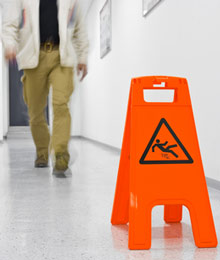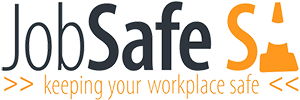 Each year over a third of all major injuries reported are the result of slips and trips and are the single most common injury in the workplace. In both manufacturing and the services industry, injuries from slips and trips are the most common cause of non-fatal major injury. The food industry in particular has the highest incidence (about twice the average rate for manufacturing industry). However, effective solutions are often simple, cheap and should be part of a system to manage hazards in the workplace.
Each year over a third of all major injuries reported are the result of slips and trips and are the single most common injury in the workplace. In both manufacturing and the services industry, injuries from slips and trips are the most common cause of non-fatal major injury. The food industry in particular has the highest incidence (about twice the average rate for manufacturing industry). However, effective solutions are often simple, cheap and should be part of a system to manage hazards in the workplace.
Slips
Slips happen where there is too little friction or traction between the footwear and the walking surface. Common causes of slips are:
- wet or oily surfaces,
- occasional spills and splashes of liquids
- weather hazards – change from a wet to a dry surface
- dusty floors
- sloping surfaces
- loose, unanchored rugs or mats, and
- flooring or other walking surfaces that do not have same degree of traction in all areas.
Trips
Trips happen when your foot collides (strikes, hits) an object causing you to lose balance and, eventually fall. Most trip injuries are caused by obstructions on the floor. The rest are caused by uneven walking surfaces. Remember that employees moving about may not always be able to see where they are putting their feet, especially if they are carrying things
Common causes of trips are:
- obstructed view,
- clutter in your way,
- wrinkled carpeting,
- uncovered cables,
- holes or cracks,
- bottom drawers not being closed, and
- uneven (steps, thresholds) walking surfaces.
Increased risk may arise from hazards due to other factors such as poorly organised walk ways, inadequate/unsuitable lighting, incorrect cleaning procedures, rushing around, fatigue and moving or handling a load.
Slips and trips are the second most common cause of injuries found in the workplace. Common injuries that occur with these are:
- Cuts and grazes
- Bruises
- Sprains and strains
- Fractures
- Loss of consciousness
Flooring
Division 2.3 (Buildings and their Precincts) of The Occupational Health and Safety Regulations 1995 state that floors must have an even, unbroken and slip-resistant surface that as far as reasonable is free of indentations or other obstructions that could cause a person to trip or stumble.
- The floor in a workplace must be suitable for the type of work activity that will be taking place on it.
- Where a floor can not be kept dry, people should be able to walk on the floor without fear of a slip despite any contamination that may be on it – it should have sufficient roughness.
- The floor must be cleaned correctly to ensure that it does not become slippery or keeps its slip resistance properties (if a non slip floor).
- The floor must be fitted correctly
- to ensure that there are no trip hazards
- to ensure that non slip coatings are correctly applied
- The floor must be maintained in good order to ensure that there are no trip hazards e.g. holes, uneven surfaces, curled up carpet edges
- Ramps, raised platforms and other changes of level should be avoided, if they cant they must be highlighted with signs or paint.
Stairs should have:
- high visibility, non slip, square ends on the step edges,
- a suitable handrail,
- steps of equal height and
- steps of equal width.
Contamination
Most floors only become slippery once they become contaminated. Prevent contamination and you reduce or even eliminate the slip risk. Contamination can be classed as anything that ends up on a floor e.g. rainwater, oil, grease, cardboard, product wrapping, dust etc. It can be a by-product of a work process or be due to adverse weather conditions.
First think about whether you can eliminate the problem, e.g.
- Fit effective canopies to external entranceways to stop rainwater from entering a building
- Fix leaking machines
- Change the system of work
If not, can the contamination be controlled e.g.: –
- drip trays for leaks
- lids on cups and containers
- good sized mats at building entrances to dry feet
- If you can’t stop contamination from getting onto a floor you will need to ensure that it is cleaned effectively and quickly.
Cleaning
The process of cleaning can create slip and trip hazards, especially for those entering the cleaning area. Smooth surfaces left damp by a mop are likely to be extremely slippery and trailing wires from a vacuum or buffing machine can present a trip hazard.
An effective cleaning regime requires a good management system to help you identify problem areas. Good communications are needed between at all levels e.g. between equipment and chemical suppliers to ensure suitability of the product to the type of contaminant and floor.
- Use the right amount of the right cleaning product.
- Detergent needs time to work on greasy floors.
- Cleaning equipment will only be effective if properly maintained.
- A dry mop or squeegee will reduce floor drying time
- Spot clean where possible.
People often slip on floors that have been left wet after cleaning. Stop pedestrian access to smooth, wet floors by using barriers, locking doors, or cleaning in sections.
Slips and Trips Management
50% of all trip accidents are caused by bad housekeeping. Good housekeeping is the first and the most important level of preventing falls due to slips and trips. It includes:
- cleaning all spills immediately,
- marking spills and wet areas,
- mopping or sweeping debris from floors,
- removing obstacles from walkways and always keeping them free of clutter,
- securing (tacking, taping, etc.) mats, rugs and carpets that do not lay flat,
- always closing file cabinet or low storage drawers,
- covering cables that cross walkways,
- keeping working areas and walkways well lit,
- replacing used light bulbs and faulty switches.
Without good housekeeping practices, any other preventive measures such as installation of sophisticated flooring, specialty footwear or training will never be fully effective. Good housekeeping doesn’t cost money; it just takes a little personal effort. Do all staff at your workplace (workers, managers, cleaners, maintenance technicians etc.) have a see it, sort it attitude?
| Hierarchy of Control | Examples |
| Eliminate the hazard | Remove slip and trip hazard at the design stage such as eliminating changes in floor levels; installing more power outlets through the floor and ceiling to avoid trailing cables. |
| Substitution | Resurface floors. |
| Isolation | Limit access to high risk areas |
| Engineering Controls | Apply floor treatments to increase slip resistance; improve lighting; stop leaks from equipment or pipes; provide adequate drainage to prevent pooling of contaminants; clearly mark edges of steps and any changes in floor height. |
| Administrative Controls | Implement good housekeeping practices such as clear walkways; prompt spills management; use of signage or barricades fro wet or slippery areas; training and supervision. |
| Personal Protective Equipment | Wear suitable footwear |
Selecting appropriate footwear
- Footwear can be important in preventing slips in the workplace and selecting the right shoe sole can have a big effect on reducing slip injuries. As a minimum, there should be a sensible shoe policy in force.
- Different types of footwear can perform differently in different situations. Get your suppliers advice or ask them to provide trial pairs to help you make the right choice.
- Urethane and rubber soles are often among the least slippery types on wet floors.
- Sole tread patterns should not become clogged with any waste or debris on the floor. If they do then that design of sole is unsuitable for your situation.
- Regularly check the sole of your shoes for any signs of wear.
USEFUL LINKS
Slips, trips and falls risk management tool
Slips, trips and falls in the cafe and restaurant industry
A bulletin from WorkSafe WA
Safety in the Hospitality Industry Info Sheet – Slips, Trips -Falls
See it, Asses it, Fix it, Evaluate it approach to managing slips in the hospitality industry
Slips, Trips, and Falls Checklist
This checklist should be used to assess risks associated with slips, trips and falls in the retail industry.
Acknowledgements:
www.hse.gov.uk
SafeWork SA – www.safework.sa.gov.au
Canadian Centre for Occupational Health & Safety
Guildford Borough – Slips and Trips
